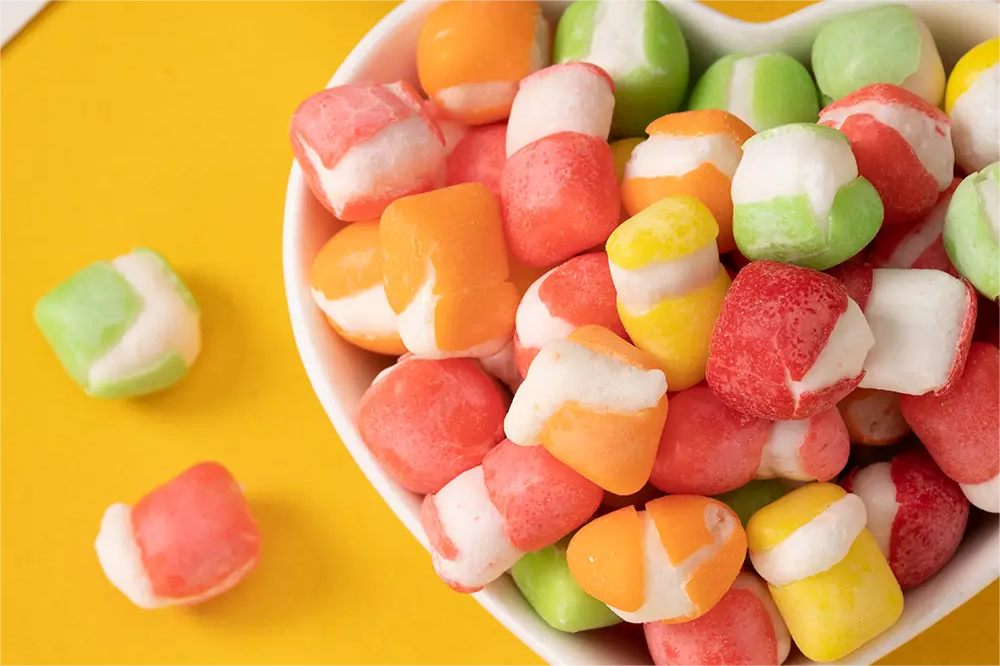Candy lovers are always on the lookout for new and exciting treats, and freeze-dried candy has quickly become a favorite for many. But what exactly sets freeze-dried candy apart from regular candy? The differences lie in the texture, flavor intensity, shelf life, and overall snacking experience.
Texture and Mouthfeel
One of the most striking differences between regular candy and freeze-dried candy is the texture. Regular candy can come in a variety of textures—chewy, hard, gummy, or soft—depending on the ingredients and preparation methods used. For example, a regular gummy bear is chewy and slightly elastic, while a hard candy like a lollipop is firm and solid.
In contrast, freeze-dried candy is characterized by its light, airy, and crunchy texture. The freeze-drying process removes nearly all the moisture from the candy, creating a product that is dry and crispy. When you bite into freeze-dried candy, it often crumbles or shatters in your mouth, offering a completely different mouthfeel compared to its regular counterpart.
Flavor Intensity
Another key difference is the intensity of flavor. Regular candy has a certain level of flavor that is diluted by the moisture content within the candy. This is true for both gummy candies, which contain gelatin and water, and hard candies, which can contain syrups and other liquids.
Freeze-dried candy, on the other hand, delivers a more concentrated flavor experience. The removal of moisture intensifies the existing flavors, making freeze-dried candy taste stronger and more vibrant. This is particularly noticeable with fruit-flavored candies, where the tangy and sweet notes are amplified, giving each bite a powerful punch of flavor.
Shelf Life and Storage
Regular candy typically has a good shelf life, especially if stored in cool, dry conditions. However, it can be susceptible to changes in texture over time, particularly in humid environments where moisture can cause candy to become sticky or lose its firmness.
Freeze-dried candy has an extended shelf life due to the removal of moisture, which is the main cause of spoilage in many foods. Without moisture, freeze-dried candy is less likely to grow mold or become stale, making it an excellent option for long-term storage. Additionally, freeze-dried candy doesn’t require special storage conditions, as it is stable at room temperature and not prone to melting or sticking.


Nutritional Content
While the freeze-drying process alters the texture and flavor of candy, it does not significantly change its nutritional content. Both regular and freeze-dried candy typically contain similar levels of sugar and calories. However, because freeze-dried candy is lighter and airier, it might be easier to consume more of it in a single sitting, potentially leading to higher sugar intake if not eaten in moderation.
The Snacking Experience
Ultimately, the choice between regular and freeze-dried candy comes down to personal preference and the type of snacking experience you’re looking for. Regular candy offers familiar textures and flavors that many people love, while freeze-dried candy provides a novel and exciting way to enjoy sweets, with its crunch and concentrated taste.
Conclusion
In conclusion, the differences between regular candy and freeze-dried candy are substantial, with variations in texture, flavor intensity, shelf life, and snacking experience. Freeze-dried candy offers a unique alternative to traditional sweets, combining the familiar flavors of your favorite candies with an unexpected crunch and long-lasting freshness. Richfield Food’s range of freeze-dried candies, including freeze-dried rainbow, freeze dried worm, and freeze dried geek, exemplifies these differences, providing a delightful treat for those looking to try something new.
Post time: Aug-23-2024